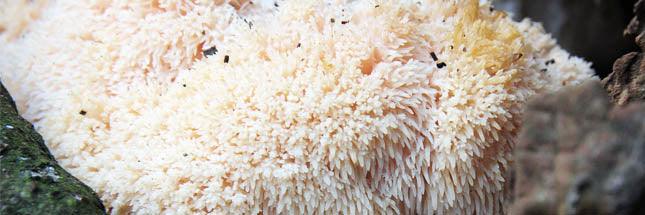QUICK FACTS
Scientific name: Hericium erinaceus
Nickname: Bear’s head, bearded tooth mushroom, bearded hedgehog mushroom, pom pom mushroom, pom pom blanc, hóu tóu gū (“monkey head mushroom” in Chinese), and yamabushitake (“mountain monk mushroom” in Japanese)
Location: Native to North America, Asia, and Europe
Known for: Cognitive support and its hearty texture and taste, which is slightly similar to lobster or crab meat
Part Used: Fruiting body and mycelia
Fun fact: In place of the traditional mushroom cap, lion’s mane has soft spines which produce and release spores to reproduce.
Good for: Immune and cognitive health
Key Properties & Actions: Antioxidant, mild antibacterial, anti-inflammatory, immunomodulatory, neuroprotective, neuroregenerative, antitumor, mild hepatoprotective, nootropic
What is Lion’s Mane?
First thing’s first: It does not come from a lion! This shaggy mushroom simply resembles a lion’s mane. Instead, it is a white, fleshy fungus that grows on dead or dying wood.
Fruiting bodies (aka the above ground portion we call a “mushroom”) resemble a mass of fragile icicle-like spines that are suspended from either a branched supporting framework or from a tough, unbranched cushion of tissue. Sizes typically range from 2.5 inches to 7 inches across, but they can be larger.
The latin name Hericium means hedgehog, and looking at the mushroom you may see some resemblance.
Delectably edible when cooked, the fruiting body and mycelia (the underground root-like portion) of this fungus also yield a variety of cognitive and immune-boosting qualities when properly extracted..
Benefits of Lion’s Mane and How It Works
Brain and Neurological Support
Promotes Mental Clarity, Focus, and Memory
Numerous animal studies and several high-quality human studies support the traditional use of lion’s mane mushroom for improvement of memory, mental clarity, and focus.2,11,13
In one small double-blind, placebo-controlled study of Japanese men and women aged 50 to 80 who had been diagnosed with mild cognitive impairment, participants showed marked improvement in cognitive function after taking lion’s mane during a 16-week period. The study also found that participants’ cognitive performance scores dropped back to pre-treatment levels within four weeks of discontinuing lion’s mane, indicating the need for ongoing use for optimal benefits.11
Increases Synthesis of Nerve Growth Factor
Lion’s mane provides nourishment for the brain, crossing the blood-brain barrier to directly support brain cells. Compounds called erinacines and hericenones are two major constituents of lion’s mane that are known to cross the blood-brain barrier and stimulate Nerve Growth Factor (NGF).8,11,12
NGF is a natural peptide produced in the body that’s essential to the growth, maintenance, and survival of nerve cells. NGF helps create new brain cells, strengthen old ones, and promote brain plasticity, important to brain development and repair. Lack of NGF is considered a contributing cause of certain neurological problems such as Alzheimer’s and dementia.
Numerous animal studies have investigated the potential mechanisms behind lion’s mane’s benefits for cognitive issues. One possible mechanism includes helping prevent beta-amyloid-related impairments of both short-term and recognition memory.13
Another animal study suggested that use of lion’s mane enhanced concentrations of both acetylcholine (a neurotransmitter) and choline acetyltransferase (an enzyme) in both serum and hypothalamus levels in the brain.18
Neuroprotective
Lion’s mane has a wide variety of studies supporting its neuroprotective effects. Primary mechanisms are believed to be due to the antioxidant and anti-inflammatory effects of consuming this mushroom.
In animal studies, lion’s mane has shown protection against premature neuron cell death due to oxidative stress, inadequate oxygenation, and physical trauma. It has also been shown to help improve the neuron myelination processes, which are critical for proper nerve impulses.1,4,5,6,10,16
Promotes Balanced Mood
In human clinical trials, administration of lion’s mane extract over four weeks showed a reduction in some symptoms of anxiety and depression in menopausal women.14
In two animal studies, use of lion’s mane showed antidepressive effects, potentially attributable to the inhibition of proinflammatory compounds typically created by stress. These findings suggest that lion’s mane and lion’s mane derivatives could be an adjunctive therapy for preventing inflammation-related depression.3,17
Immune Health
Lion’s mane contains polysaccharides (a type of carbohydrate), and in particular a type called beta-glucans, which have been shown to support immune health and overall wellness, as well as healthy cell growth and turnover.
Fungal polysaccharides are found mainly in cell walls, and are present in large quantities in both fruiting bodies and cultured mycelia. In addition to beta-glucan polysaccharides, lion’s mane also contains alpha-glucans and glucan-protein complexes, all of which exert positive effects on the immune system.10 In one animal study, four different polysaccharides isolated from lion’s mane showed antitumor activity.9
Microbiome Balance
As is common with nearly all herbs and fungi, lion’s mane appears to have some mild antimicrobial qualities that may contribute to its ability to support a healthy microbiome and promote gut health.
History & Traditional Use
Lion’s mane has a long history of use (1000+ years) in traditional Chinese medicine (TCM). TCM has long prescribed lion’s mane for stomach problems and cancer of the digestive organs. In Chinese and Japanese medical systems, it has traditionally been used to fortify the spleen and nourish the gut, and also as an cancer treatment adjunct.7
From a TCM perspective, lion’s mane is said to be nutritive to the five internal organs — the liver, lungs, spleen, heart, and kidneys — and promote good digestion, general vigor, and strength. It has also been recommended for gastric and duodenal ulcers, as well as chronic gastritis.15

The mushroom is also known for its effects on the central nervous system, and has been used for insomnia and weakness. Both symptoms are characteristic of what is referred to as a ‘Qi deficiency’ in TCM; Qi is considered the life force or life energy that flows through us.
As a food, this culinary mushroom can be an excellent component in your daily diet because it is rich in proteins, fibers, carbohydrates, vitamins, and minerals. At the same time, like many other mushrooms, it is low in calories and unhealthy fats.
How to Use and Dosing

While only the fruiting body of lion’s mane has been used in traditional Chinese medicine, modern research is showing that both the mycelium and fruiting body provide medicinal benefits. Benefits may be gained from eating this mushroom after it has been well cooked, but taking it in a prepared extraction will deliver even more concentrated therapeutic effects.
Look for a water-alcohol extract of both the fruiting body and mycelia in order to optimize benefits for both neurological and immune system support. Ideally, choose an extract standardized to 4% beta glucans (immune supporting compounds) as a good indicator of potency.
Depending on the product quality and concentration, general dosing ranges are between 250 mg to 500 mg, 1 to 2 times daily.
For cognitive support, lion’s mane works well with other herbs such as bacopa, ashwagandha, cat’s claw, and ginkgo. For immune support, consider taking it with herbs like reishi, andrographis, turmeric, cordyceps, rehmannia, and Chinese skullcap.
Interactions
None are known, but always check with your healthcare practitioner before use if you are taking medications.
Precautions & Side effects
This mushroom has a very good safety profile. Avoid use if you are allergic to mushrooms. Consult your healthcare practitioner regarding the use of this product during pregnancy.
Disclaimer: The information in our ingredients pages is intended as a general reference for educational purposes only and is not a replacement for professional health advice. Any mentioned dosage recommendations, safety notices, or possible interactions with prescription drugs are for educational purposes only and must be considered in the context of each individual’s health situation. Accordingly, this information should be used only under the direct supervision of a qualified healthcare practitioner.
References
1. Abdullah, Noorlidah, Siti Marjiana Ismail, Norhaniza Aminudin, Adawiyah Suriza Shuib, and Beng Fye Lau. 2012. “Evaluation of Selected Culinary-Medicinal Mushrooms for Antioxidant and ACE Inhibitory Activities.” Research Article. Evidence-Based Complementary and Alternative Medicine. 2012. https://doi.org/10.1155/2012/464238.
2. Brandalise, Federico, Valentina Cesaroni, Andrej Gregori, Margherita Repetti, Chiara Romano, Germano Orrù, Laura Botta, et al. 2017. “Dietary Supplementation of Hericium Erinaceus Increases Mossy Fiber-CA3 Hippocampal Neurotransmission and Recognition Memory in Wild-Type Mice.” Evidence-Based Complementary and Alternative Medicine : ECAM 2017. https://doi.org/10.1155/2017/3864340.
3. Chiu, Chun-Hung, Charng-Cherng Chyau, Chin-Chu Chen, Li-Ya Lee, Wan-Ping Chen, Jia-Ling Liu, Wen-Hsin Lin, and Mei-Chin Mong. 2018. “Erinacine A-Enriched Hericium Erinaceus Mycelium Produces Antidepressant-Like Effects through Modulating BDNF/PI3K/Akt/GSK-3β Signaling in Mice.” International Journal of Molecular Sciences 19 (2). https://doi.org/10.3390/ijms19020341.
4. Kuo, Hsing-Chun, Chien-Chang Lu, Chien-Heng Shen, Shui-Yi Tung, Meng Chiao Hsieh, Ko-Chao Lee, Li-Ya Lee, et al. 2016. “Hericium Erinaceus Mycelium and Its Isolated Erinacine A Protection from MPTP-Induced Neurotoxicity through the ER Stress, Triggering an Apoptosis Cascade.” Journal of Translational Medicine 14 (March). https://doi.org/10.1186/s12967-016-0831-y.
5. Lee, Kam-Fai, Jiann-Hwa Chen, Chih-Chuan Teng, Chien-Heng Shen, Meng-Chiao Hsieh, Chien-Chang Lu, Ko-Chao Lee, et al. 2014. “Protective Effects of Hericium Erinaceus Mycelium and Its Isolated Erinacine A against Ischemia-Injury-Induced Neuronal Cell Death via the Inhibition of INOS/P38 MAPK and Nitrotyrosine.” International Journal of Molecular Sciences 15 (9): 15073–89. https://doi.org/10.3390/ijms150915073.
6. Li, I.-Chen, Li-Ya Lee, Tsai-Teng Tzeng, Wan-Ping Chen, Yen-Po Chen, Young-Ju Shiao, and Chin-Chu Chen. 2018. “Neurohealth Properties of Hericium Erinaceus Mycelia Enriched with Erinacines.” Review Article. Behavioural Neurology. 2018. https://doi.org/10.1155/2018/5802634.
7. Liu, Jianqing, Congxin Du, Yifei Wang, and Zhihua Yu. 2015. “Anti-Fatigue Activities of Polysaccharides Extracted from Hericium Erinaceus.” Experimental and Therapeutic Medicine 9 (2): 483–87. https://doi.org/10.3892/etm.2014.2139.
8. Ma, Bing-Ji, Jin-Wen Shen, Hai-You Yu, Yuan Ruan, Ting-Ting Wu, and Xu Zhao. 2010. “Hericenones and Erinacines: Stimulators of Nerve Growth Factor (NGF) Biosynthesis in Hericium Erinaceus.” Mycology 1 (2): 92–98. https://doi.org/10.1080/21501201003735556.
9. Mizuno, Takashi, Tetsuya Wasa, Hitoshi Ito, Chilharu Suzuki, and Nobuo Ukai. 1992. “Antitumor-Active Polysaccharides Isolated from the Fruiting Body of Hericium Erinaceum, an Edible and Medicinal Mushroom Called Yamabushitake or Houtou.” Bioscience, Biotechnology, and Biochemistry 56 (2): 347–48. https://doi.org/10.1271/bbb.56.347.
10. Moldavan, Mykhaylo, Andriy P. Grygansky, Olena V. Kolotushkina, Burkhard Kirchhoff, Galina G. Skibo, and Paola Pedarzani. 2007. “Neurotropic and Trophic Action of Lion’s Mane Mushroom Hericium Erinaceus (Bull.: Fr.) Pers. (Aphyllophoromycetideae) Extracts on Nerve Cells in Vitro.” International Journal of Medicinal Mushrooms 9 (1). https://doi.org/10.1615/IntJMedMushr.v9.i1.30.
11. Mori, Koichiro, Satoshi Inatomi, Kenzi Ouchi, Yoshihito Azumi, and Takashi Tuchida. 2009. “Improving Effects of the Mushroom Yamabushitake (Hericium Erinaceus) on Mild Cognitive Impairment: A Double-Blind Placebo-Controlled Clinical Trial.” Phytotherapy Research: PTR 23 (3): 367–72. https://doi.org/10.1002/ptr.2634.
12. Mori, Koichiro, Yutaro Obara, Mitsuru Hirota, Yoshihito Azumi, Satomi Kinugasa, Satoshi Inatomi, and Norimichi Nakahata. 2008. “Nerve Growth Factor-Inducing Activity of Hericium Erinaceus in 1321N1 Human Astrocytoma Cells.” Biological & Pharmaceutical Bulletin 31 (9): 1727–32. https://doi.org/10.1248/bpb.31.1727.
13. Mori, Koichiro, Yutaro Obara, Takahiro Moriya, Satoshi Inatomi, and Norimichi Nakahata. 2011. “Effects of Hericium Erinaceus on Amyloid β(25-35) Peptide-Induced Learning and Memory Deficits in Mice.” Biomedical Research (Tokyo, Japan) 32 (1): 67–72. https://doi.org/10.2220/biomedres.32.67.
14. Nagano, Mayumi, Kuniyoshi Shimizu, Ryuichiro Kondo, Chickako Hayashi, Daigo Sato, Katsuyuki Kitagawa, and Koichiro Ohnuki. 2010. “Reduction of Depression and Anxiety by 4 Weeks Hericium Erinaceus Intake.” Biomedical Research 31 (4): 231–37. https://doi.org/10.2220/biomedres.31.231.
15. Thongbai, Benjarong, Sylvie Rapior, Kathrin Wittstein, Kevin Hyde, and Marc Stadler. 2015. “Hericium Erinaceus, an Amazing Medicinal Mushroom.” Mycological Progress 14 (August): 1–23. https://doi.org/10.1007/s11557-015-1105-4.
16. Wong, Kah-Hui, Murali Naidu, Pamela David, Mahmood Ameen Abdulla, Noorlidah Abdullah, Umah Rani Kuppusamy, and Vikineswary Sabaratnam. 2011. “Peripheral Nerve Regeneration Following Crush Injury to Rat Peroneal Nerve by Aqueous Extract of Medicinal Mushroom Hericium Erinaceus (Bull.: Fr) Pers. (Aphyllophoromycetideae).” Evidence-Based Complementary and Alternative Medicine: ECAM 2011: 580752. https://doi.org/10.1093/ecam/neq062.
17. Yao, Wei, Ji-chun Zhang, Chao Dong, Cun Zhuang, Susumu Hirota, Kazutoyo Inanaga, and Kenji Hashimoto. 2015. “Effects of Amycenone on Serum Levels of Tumor Necrosis Factor-α, Interleukin-10, and Depression-like Behavior in Mice after Lipopolysaccharide Administration.” Pharmacology, Biochemistry, and Behavior 136 (September): 7–12. https://doi.org/10.1016/j.pbb.2015.06.012.
18. Zhang, Junrong, Shengshu An, Wenji Hu, Meiyu Teng, Xue Wang, Yidi Qu, Yang Liu, Ye Yuan, and Di Wang. 2016. “The Neuroprotective Properties of Hericium Erinaceus in Glutamate-Damaged Differentiated PC12 Cells and an Alzheimer’s Disease Mouse Model.” International Journal of Molecular Sciences 17 (11). https://doi.org/10.3390/ijms17111810.





